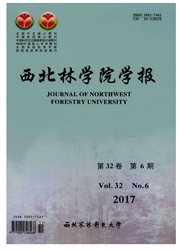

 中文摘要:
中文摘要:
为研究锐齿栎的天然更新状况,采用典型样地调查法对火地塘林区锐齿栎的更新密度与频度进行了调查,并通过灰色关联法对影响锐齿栎林天然更新的环境因子进行了分析。结果表明:(1)样地调查中以锐齿栎+油松林下更新状况最好,更新密度为8 812株.hm-2;其次是锐齿栎纯林,更新密度为5 960株.hm-2;锐齿栎+梾木林下更新密度最小,为5 750株.hm-2。(2)优势树种锐齿栎的更新状况明显优于其他树种,更新密度最高可达2 500株.hm-2,频度可达62%。(3)影响锐齿栎更新的11个环境因子关联度排序为:林分密度〉针叶树株数〉海拔〉土壤容重〉郁闭度〉坡度〉凋落物厚度〉非毛管孔隙度〉总孔隙度〉土壤厚度〉灌草盖度。其中可控制因子林分密度、针叶树株数在一定范围内可促进天然更新;郁闭度在70%~75%之间时,林下更新密度较大。因此,可通过调节这些因子促进锐齿栎林天然更新。
 英文摘要:
英文摘要:
Abstract. The natural regeneration of Quercus aliena var. acuteserrata forests was studied by surveying the sample plots in Huoditang forest areas, and the main environmental factors of regeneration were analyzed by grey relational analysis method. The results are reported as follows. (1) Regeneration seedlings were growing well, with a maximum renewal density of 8 812 plants per hm2 in Q. aliena var. acuteserrata mixed Pinus tabulaeformis forest, the midlle renewal density of 5 960 plants per hm2 in pure Q. aliena var. acuteserrata forest and a minimum renewal density of 5 750 plants per hm2 in Q. aliena var. acuteserrata mixed Swida macrophylla forest. (2) Regeneration of Q. aliena var. acuteserrata which was the dominant tree species was better than other tree species, with a maximum renewal density of 2 500 plants per hm2 , and the frequency of Q. aliena var. acuteserrata was 62%. (3) Relational grade sequence of environmental factors which affected forest regeneration were in the order of stand density 〉 conifer number altitude 〉soil bulk density 〉canopy density 〉 gradient 〉 arbor trees coverage 〉 non-capillary po- rosity 〉total porosity 〉 soil thickness 〉 shrub and grass coverage. The artificial controllable factors, such as stand density and conifers number could promote the natural regeneration within a certain scope, and canopy density in 70%- 75% could remain a bigger renewal density. Therefore, the natural regeneration of Q. aliena var. acuteserrata may be promoted by adjusting these controllable factors.
 同期刊论文项目
同期刊论文项目
 同项目期刊论文
同项目期刊论文
 Seed dispersal by small rodents favors oak over pine regeneration in the pine-oak forests of the Qin
Seed dispersal by small rodents favors oak over pine regeneration in the pine-oak forests of the Qin 期刊信息
期刊信息
